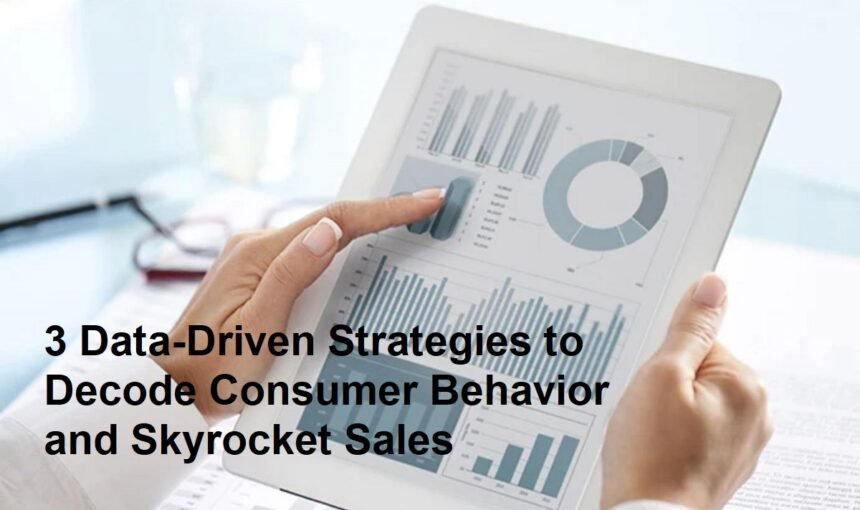Introduction
In today’s hypercompetitive market, understanding consumer behavior is the cornerstone of boosting sales and achieving sustained business growth. With 76% of consumers expecting personalized experiences and 64% abandoning brands that fail to meet their expectations (Salesforce, 2023), businesses must adopt innovative methods to decode purchasing patterns, preferences, and pain points. This article explores three actionable strategies—leveraging data analytics, conducting targeted market research, and applying behavioral psychology—to align products and marketing efforts with consumer needs, ultimately driving sales and fostering brand loyalty.
- Harness Advanced Data Analytics to Predict Trends
The Power of Big Data
Modern businesses generate vast amounts of data from online transactions, social media interactions, and website traffic. Tools like Google Analytics, CRM systems, and AI-driven platforms such as Adobe Sensei enable companies to analyze this data in real time, identifying trends that influence purchasing decisions. For instance, Amazon’s recommendation engine, which drives 35% of its revenue, uses machine learning to analyze browsing history and predict what customers are likely to buy next.
Key Metrics to Track
- Purchase Frequency: Identify how often customers return to buy products.
- Cart Abandonment Rates: Pinpoint friction points in the checkout process.
- Demographic Patterns: Segment audiences by age, location, or income to tailor marketing campaigns.
Case Study: Netflix’s Personalization Strategy
Netflix saves $1 billion annually by reducing customer churn through data analytics. By tracking viewing habits, the platform curates personalized content recommendations, ensuring users remain engaged and subscribed. Similarly, small businesses can use free tools like HubSpot to automate personalized email campaigns, increasing conversion rates by up to 14%.
- Conduct In-Depth Market Research and Surveys
Direct Feedback for Actionable Insights
While data analytics reveals what consumers do, surveys and focus groups explain why they do it. Platforms like SurveyMonkey or Qualtrics allow businesses to gather direct feedback on product satisfaction, pricing perceptions, and unmet needs. For example, Starbucks uses its “My Starbucks Idea” platform to crowdsource customer suggestions, which led to innovations like mobile ordering and dairy-free milk options.
Types of Effective Research
- A/B Testing: Compare two versions of a product page or ad to determine which resonates more.
- Ethnographic Studies: Observe consumers in real-life settings to uncover unspoken preferences.
- Sentiment Analysis: Use AI tools like Brandwatch to analyze social media conversations and gauge brand perception.
Case Study: Coca-Cola’s “Share a Coke” Campaign
By analyzing survey data, Coca-Cola discovered that millennials valued personalization. This insight birthed the “Share a Coke” campaign, where bottles featured popular names. The result? A 2% increase in U.S. sales after a decade of decline, proving that aligning with consumer desires drives revenue.
- Apply Behavioral Psychology Principles
Nudging Consumers Toward Purchase Decisions
Behavioral economics reveals that purchasing decisions are often irrational and emotion-driven. Tactics like scarcity (“Only 3 left in stock!”), social proof (customer reviews), and anchoring (showing a high original price next to a discount) can significantly influence buying behavior. For instance, Booking.com increased conversions by 10% by highlighting limited room availability.
The FOMO (Fear of Missing Out) Effect
Platforms like Instagram and TikTok thrive on FOMO, with 60% of millennials making impulse purchases after seeing limited-time offers on social media. Flash sales, countdown timers, and exclusive memberships (e.g., Amazon Prime) exploit this psychology to accelerate sales.
Case Study: Apple’s Scarcity Marketing
Apple’s deliberate underproduction of initial iPhone stocks creates artificial scarcity, driving frenzied pre-orders and media buzz. This strategy not only boosts sales but also positions products as “must-have” status symbols.
Conclusion: Building a Consumer-Centric Sales Engine
Decoding consumer behavior is not a one-time effort but a continuous process of adaptation. By integrating data analytics, direct feedback, and behavioral insights, businesses can craft hyper-targeted strategies that resonate with their audience. For example, Nike’s use of wearables (data) combined with personalized training apps (psychology) has solidified its position as a market leader. As consumer expectations evolve, companies that prioritize understanding their audience will not only survive but thrive in the digital age.









